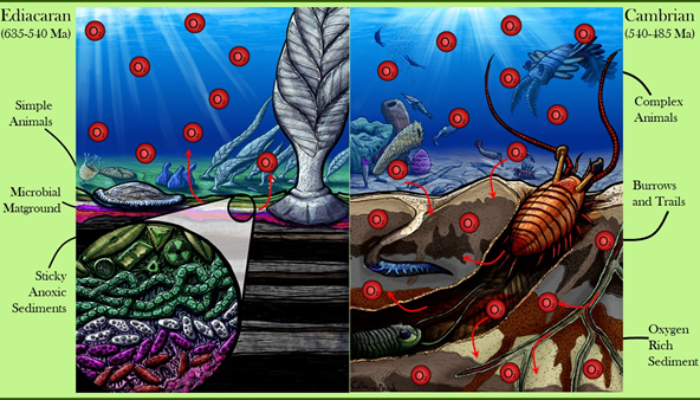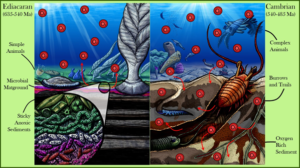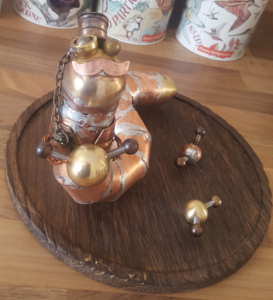
Slime is important to the developments of Earth’s landscapes – I have already explored this in a previous post where I learnt how Extracellular Polymeric Substances (EPS), a fancy phrase for a slime produced by organisms, can bind sediments together and making them resistant to erosion. This has impacts on the development of landscapes, from the types of bedforms forming below flows, the rate at which cliffs erode, and the shape deltas take. However, it seems this is just the beginning and the more you dig the greater the influence this slime has had on the planet and its inhabitants.
Let’s go back to the deep ocean, 635 million years ago, where the waters are well oxygenated and full of simple plants and animals. Fast-forward over a hundred million years, beginning 540 million years ago, and there is a sudden explosion in the evolution of life, with ecosystems similar to the present day emerging and the lifeforms becoming my complex. We have travelled from the Ediacaran to the Cambrian and the world has been turned upside down.
I spoke to a couple of researchers at the Energy and Environment Institute, University of Hull, who are researching this sudden change. They work on a project called Worms on Film and both are using art as a way of communicating their research. Catherine Mascord explained to me –
“Before this transition, with nothing to disturb them Precambrian seafloors, including those of the Ediacaran, are generally characterised by prevalent anoxia and sulphur rich sediments. Without animals to break up and disturb the sediment most of the seafloor was blanketed in a thick community of microbes, known as a microbial matground, formed when bacteria and other microorganisms glue themselves and their host sediment together through the secretion of EPS.”
A talented scientist and artist, Catherine uses her talents to communicate her research. This diagram shows the difference between the surface/sub-surface eco-systems of the Ediacaran and the Cambrian.
It was the evolution of burrowing animals, like worms, that initiated the transition from the Ediacaran to the Cambrian, and Catherine’s research is helping us understand this better through a mix of field work and experiments using modern worms.
“We can use modern animals with similar burrowing behaviours as models for ancient animals and use then to help figure out how an animal behaves in Ediacaran-like conditions.”
These worm-like burrowers were key to breaking through the 2-dimensional habitat that was being reinforced by EPS. The sub-surface was barren, de-oxygenated, and lifeless. The emergence of the burrowers broke through this crust and enabled the sub-surface to be oxygenated. I spoke to Jenny James, who is researching the links between climate change and mass-extinctions as part of Worms on Film.
“Marine worms are eco-system engineers; they increase oxygen penetration depth into the sediment allowing microbiota to survive at a greater depth and speeding up the process of nutrient cycling; they also stabilise the sediment by secreting a mucus-like substance (EPS) to line their burrows.”
Although the burrows made by the worms are reinforced, they are not invincible and changes to the planet’s climate can impact on the eco-systems they create. Moving forward in time again to the end of the Permian (252 million years ago) and once again the ocean floor is a barren, 2-dimensional landscape. Rising atmospheric Carbon Dioxide levels at that time caused an acidification of the oceans.
“The knock-on effects on marine ecosystems can often be seen in the fossil record as a rapid decline in biodiversity and even a loss of trace fossils such as burrows and surface trails. The End Permian mass extinction saw a prolonged gap in burrowing animals such as worms and bivalves and because of this, the 3-dimensional benthic habitat became barren and 2-dimensional.”
Also a talented scientist and artist, Jenny sculpted this steampunk representation of a Harbour Ragworm and the Carbon Dioxide so influential to its eco-system.
Jenny is using a particularly resilient species of worm, the Habour Ragworm, to identify whether these patterns seen in the geological record could be repeated due to anthropogenic climate change.
“Similar patterns are beginning to occur today with rapidly declining populations of most vulnerable marine animals such as corals.”
Once again, I am amazed at the impact that small animals, microorganisms, and the mucus they secrete have had in shaping the planet we see today. It seems from the research Catherine and Jenny have showed me, and the results they will produce in the future, that these creatures are not finished shaping our landscapes just yet.
EPS will return in Slimy Landscapes 3.*
*suggestions for titles welcome!


